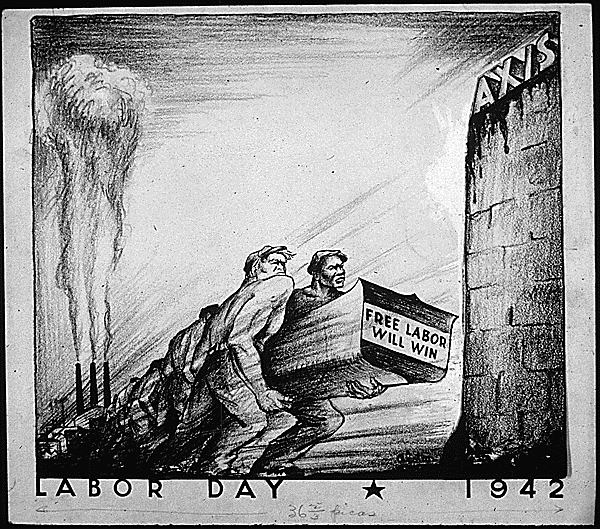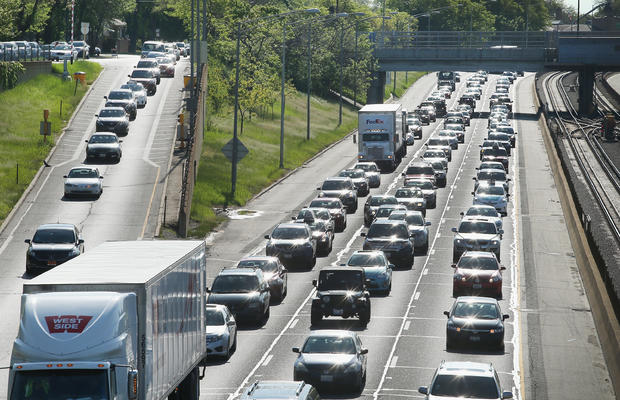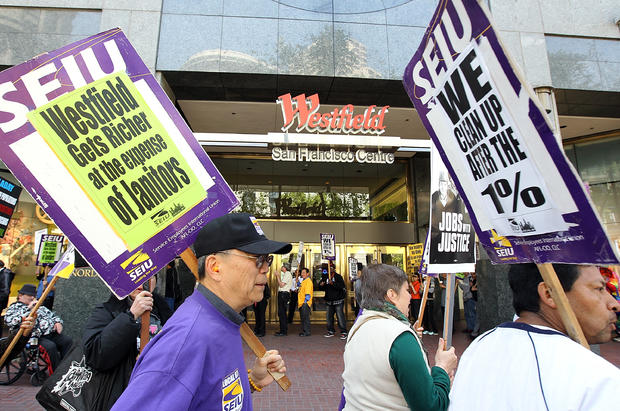Labor Day: America at work
1942 illustration by Charles Alston for the Office of War Information
On Sept. 5, 1882, some 10,000 people gathered in upper Manhattan at Wendel's Elm Park for a parade dedicated to an idea much in the news at the time: the dignity of workers.
So was born Labor Day, or at least its modern incarnation. Although Congress didn't designate the first Monday of September as an official holiday until 1894, the earlier march embodied the landmark social change underway in the U.S. at the time. The effects of that change, which would go on to transform politics and help give rise to the American middle class, continue to be felt to this day.
It's easy to forget, in the rush to squeeze out one last summer outing or to prepare children for the new school year, what Labor Day is really about. To that end, here's a snapshot of what it means to work in America today.
Most common job
As of last year, 4.5 million people worked in the retail sector, making it the country's largest occupational grouping, according to the U.S. Census Bureau.
The average 2012 median pay in retail was $10.29 an hour, or $21,410 a year, according to the U.S. Labor Department. Employment in retail sales is forecast to grow roughly 10 percent over the next decade or so, in line with other professions.
The wild card? The Internet. The explosion of online shopping could curb demand for salespeople, according to the agency. And the explosion of part-time and temporary jobs in retail has also left many workers with low pay and few benefits.
The second-most common job in the U.S. these days is cashier, employing 3.3 million workers, followed by food preparation and service, office clerks and nurses. The largest occupation a century ago? Farmers. The fastest-growing field over the next eight years or so is nursing.
What we earn
As of 2012, the real median annual earnings for full-time, year-round workers was $49,398 for men and $37,791 for women, according to the U.S. Census Bureau. That was about $1,000 a less per year than the median pay in 2009, as the financial crisis was hitting the U.S. economy.
In reality, however, and despite the existing gender gap in earnings, men's earnings have been stagnant for decades, while women have gained ground. In 1973, the high-water mark for males, median pay for men was $51,670. The median that year for women was $29,262.
The upshot: For all but the wealthiest Americans, wages have been growing very slowly -- or shrinking, depending on the income segment you look at -- for decades. The large majority of U.S. workers have seen their hourly wages stagnate or decline since 1979, the Economic Policy Institute said in a recent report.
Our daily commute
American workers spend an average of 25.7 minutes traveling to work, according to the U.S. Census Bureau. By state, the longest daily commutes in the nation were in Maryland and New York, at nearly 32 minutes, with New Jersey (30.7 minutes), the District of Columbia (29.9 minutes) and Massachusetts (28.3 minutes) rounding out the top five.
The state with the shortest average daily commute? South Dakota, where its takes an average of just under 17 minutes to get to work.
Most people leave for work between 7 a.m. and 7:29 a.m., while an unfortunate 4.4 percent of workers have to start their commutes between midnight and 5 a.m.
Although roughly three-quarters of workers drove to work alone in 2012, more commuters are traveling to work by bicycle these days. Between 2008 and 2012, the number of workers who did so rose from about 488,000 to 786,000, federal data show. The U.S. city with greatest share of employees, at 6.1 percent, who make their way to work on two wheels: Portland.
After hours
The average employee works 7.6 hours per day, the U.S. Labor Department reports. Men tend to work longer days than women, at 8.3 hours and 7.7 hours per day, respectively. Some 83 percent of people work on weekdays, versus only 34 percent who work on the weekend.
What do employees like to do after work? Watching TV is the leisure activity that occupies the most time, at 2.8 hours per day. The next most common thing to do is to visit friends or attend a social event (43 minutes), followed by sports, exercise or similar recreation (30 minutes).
Decline of unions
As of 2013, 11.3 percent of wage and salary workers, or 16 million people, were represented by a labor union. That includes union members and nonmember employees who are covered by union contract.
Union representation has fallen sharply over the last three decades. In 1983, more than a fifth of workers, or nearly 18 million people, were covered by a union contract.
Workers in education, training and library jobs had the highest rate of unionization, with roughly 35 percent of employees belonging to a labor group. New York has the highest rate of union membership in the U.S., at roughly 24.4 percent, while North Carolina has the lowest (3 percent).
Precious little time
The average private-sector worker in the U.S. gets 10 days of paid vacation and six paid holidays per year.
How does that compare with off time for employees in another advanced economies? Not so hot. In France, the most generous industrialized country when it comes to vacation, workers get a minimum of 30 paid days off per year, according to the Center for Economic and Policy Research.
The U.K. comes in at No. 2, with 28 vacation days, followed by Denmark, Finland, Norway and Sweden (25 days).
Only Japan is stingier with paid time off than the U.S. among advanced economies, with the average worker there getting 10 paid vacation days and no paid holidays.






